Project management analysis – managing a one day training event.
Project Background
Big Idea Ltd plans to organise a one day training event in project management with a specific focus on the application of the MS Project software in the Critical Path Analysis (CPA) method. The company has no experience in managing events of such calibre in the past, which is why several companies with expertise in project management have been approached with a request for a solution of how the event should be managed.
The company Project management Ltd (PML) offered the following analysis.
Project Concept and Strategy
PMBOK and PRINCE2 are standard project methodologies used by many PM practitioners across the world. The both methodologies recommend the projects to begin with a project initiation phase in which a clear identification of the customer’s, in this case, the owner’s requirements is made (PMI 2008, OGS 2005).
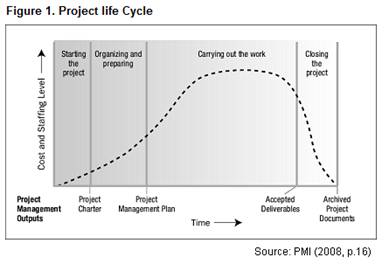 In the case of Big Idea’s project, PM practitioners as Field and Keller (2007:8-15) and Gardiner (2005) recommend preparing a Feasibility study, or a Business Case. The Business Case is a standard tool in project management, which aims to provide a financial, technical and managerial analysis of the identified solution for realising the client’s requirements. The Business Case enables the Management team to make a decision on the future development of the project, its objectives and scope (Field and Keller 2007: 25-40).
In the case of Big Idea’s project, PM practitioners as Field and Keller (2007:8-15) and Gardiner (2005) recommend preparing a Feasibility study, or a Business Case. The Business Case is a standard tool in project management, which aims to provide a financial, technical and managerial analysis of the identified solution for realising the client’s requirements. The Business Case enables the Management team to make a decision on the future development of the project, its objectives and scope (Field and Keller 2007: 25-40).
The outputs of the project initiation phase are: (1) an Appointed Project Manager and a (2) Project Initiation Document (PID). In the process of the initial project development and definition of the project objectives, the project practitioners as Turner (2009) and Kerzner (2009) recommend an identification of two sets of factors for measuring the project success. The first set is made out of the success criteria, or the dependent variables by which the successful outcome of the project will be assessed: time, cost and quality. The second set defines the success factors or the independent variables which influence the successful achievement of the success criteria. In essence the later set is made out of the key project assumptions and constraints (PMI 2008).
In the case of the Big Idea’s project and having in mind the preceding sections, the identification of the project objectives is: To prepare a one day UG Project Management training programme for Level 3 undergraduate students on the use of Microsoft Project and Critical Path Analysis for delivery on 1st October 2011 within a maximum budget of £30,000.
Once the project initiation phase ends and the project is approved, the next phase in the project life cycle is the project development phase. It is the most important phase of all PLC phases; the phase that makes or breaks the project. It is when the project is refined, project team formed, plans set and all the preparations for implementing, monitoring, and controlling of project activities completed (Field and Keller 2007, Gardiner 2005, Taylor 2006). The phase is crucial in establishing project boundaries and identifying project details and requirements. In the words of Taylor (2006, p. 215) “the activities of the developmental phase operationalise the activities of the conceptual phase.” As a result this phase ends with two tangible deliverables/outcomes (OGC 2005, PMI 2008):
- The Project team ; and
- The Project management documentation.
The main activities in the longest phase of the project life cycle include securing the necessary resources for execution of the planned activities, realising the planned activities, monitoring and control and reporting on the project success; and change in planning whenever there is a required and approved change request. The main outputs of the implementation phase of the PLC are the project deliverables as identified in the planning phase.
The fourth phase of the PLC, the project closure covers closure activities directed towards the final client securing formal acceptance of project deliverables, closure or disengagement of the team and financial closure of the project activities (Field and Keller 2007, PMI 2008). The purpose of the financial audit is to show that the project has achieved the objectives within the set budget, while the lessons learned aim at providing information about the company when dealing with organisations of a similar event in the future (Williams 2003).
Project Scope
According to Turner (2009) project scoping and its subsequent management in the implementation phase of the PLC are one of the most essential project management tools and techniques ensuring project success. The project scope synthesises the project objectives with identified work packages provided with the work breakdown structure (WBS). It aims at providing clear limits of project’s boundaries, what is to be included and what is to excluded from the project.
The tool that assists the scoping process is the Work Breakdown Structure (WBS) PMI (2008:116) defines the Work Breakdown Structure as a fundamental project management mechanism which decomposes the project into several smaller work packages aiding clear identification of project scope and project activities. Therefore, the Work Breakdown Structure serves not only in clearly identifying project scope and schedule, but as well as a scope control tool during project execution. Depending on the project management best practice present in a particular industry, the Work Breakdown Structure can be product based or based on the phases of the Project Life Cycle (PMI 2008:117, Gardiner 2005). The best practice in the events industry, suggests the use of product based Work Breakdown Structure for the concerned project. In a product based Work Breakdown Structure, the work packages are identified on a level of a finished product. The Work Breakdown Structure is presented in Figure 2.
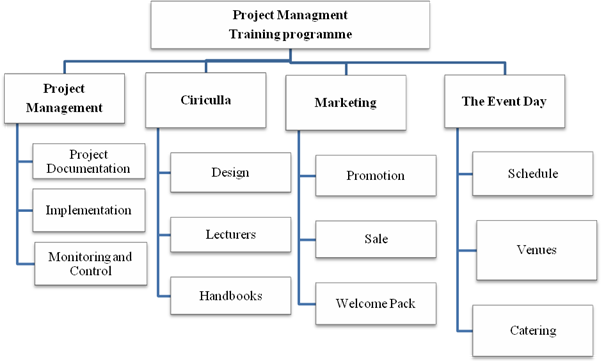
Having in mind the identified work packages from the Work Breakdown Structure and the Project objectives, the Scope of the Project is to: develop project documentation, develop curricula for the training accompanied with Lecturers and handbooks, prepare a marketing campaign to promote and sale the event, develop the event day schedule and arrange for food and beverages.
The main themes which will be covered at the training day are developed according to the suggestions of Microsoft and the Project Learning net (2011).
| Table 1. Main Themes To be Covered at the Training | |
| 1. | Project preliminaries – Getting started with Microsoft Project. |
| 2. | Planning the work and Project Planning Techniques (CPA) – Creating, organizing and managing the project’s outline. |
| 3. | Reviewing the schedule with an analysis of the critical path. |
| 4. | Assigning people and costs. |
| 5. | Managing external influences. |
| 6. | Viewing, analysing and reporting. |
| 7. | Optimizing people and plan. |
| 8. | Progressing the plan. |
| 9. | Case study presentations, and discussion |
The themes will be covered in four sessions of trainings with timing of two hours each. Two coffee and refreshment breaks of 15 minutes each and one lunch break of 60 minutes are planned during the training day.
Project team and structure
One of the benefits of the Work Breakdown Structure is that the tool provides a clear understanding of project activities enabling a clear division of responsibilities (PMI 2008). As a result the Work Breakdown Structure enables the creation of the project management team structure. The structure project team for the MS Project Training event is provided in Figure 3.
The required project organisation is a task based organisational structure, where the project team is divided in task groups covering specific packages of the project (PMI 2008). The reporting relationship is bottom up.
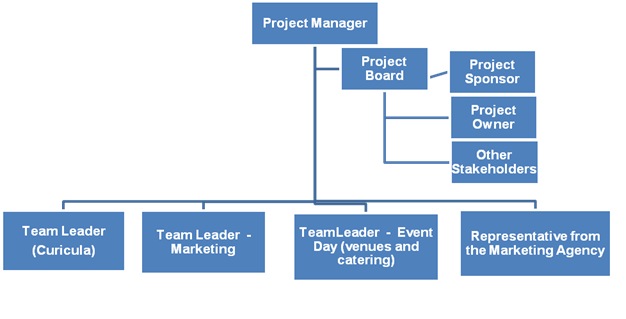
![]()
Project Board / Project Owner
Project Manager (Leadbetter)
The composition of the project team will vary according to the project phases. During the project planning phase the team will be made only by the task leaders, while in the implementation and closing phase of the project life cycle, the project team will expand in each of the work packages including representatives from the contractors (Marketing agency, Venue provider, Caterer) and an input from the contracted lecturers.
Project management plan
PMI (2008, p.78) defines ‘the development of the project management plan as a process of documenting the actions necessary to define, prepare, integrate and coordinate all subsidiary plans’. The project management plan sets the boundaries of the project and identifies how the project will be executed, monitored, controlled and closed. Therefore, its purpose is twofold: (1) it serves to communicate the intentions of the project and (2) to assist the control over the project in the project implementation phase. In line with literature recommendations, the project management plan should cover the following elements: (PMI 2008: 43):
- Project Schedule;
- Project Quality plan;
- Project Budget with resource analysis;
- Project Risk management plan
- Project Communications plan;
Key project constraints are:
- The maximum budget for the project set to £30 000;
- The training must be delivered on October 1st 2011;
Key project assumptions used in the further development of the project schedule and budget are:
- The allocated resources are available in the preparation period;
- The project management fee for the project team is 10% of the maximum project cost i.e. £3,000.
- There will be four training sessions each lasting two hours covered by one Academic Lecturer and three Practitioners in the field. The Academic Lecturer will be contracted for preparation and review of the training material included in the handbook, and for his presence and module lead during the training day at a maximum fee of £2,000, while the Practitioners will be contracted pro bono (£100 fee for transportation and lunch) for the event day only as a way of self-promotion.
- Ideally the rented venue will be a computer lab equipped with the required equipment for the training as are projectors and laptops. The cost for the day is estimated on £1,000.
- The catering is estimated at a fixed fee of £1,000, which is a sum that could satisfy a maximum number of100 participants and guests.
- The Promotion Agency will be contracted for the promotional plan and for its participation in the subsequent activities with a fixed fee of £3,000, while the additional costs covering the promotional plan (printing leaflets, posters, online banners, social media coverage and radio ads), including the printing of the handbook and the welcome pack will be £19,000.
- In the schedule, the preparing of the handbook and the welcome pack depends upon the approval of the promotional plan.
Project schedule
The Work Breakdown Structure serves as the base for the further development of the schedule and budget. These elements of the project documentation are made through an initial identification of the required project activities for accomplishing each work package. The process of time estimation begins once the project packages are divided into activities. According to Gray and Larson (2010: 97-98), an estimation is a process of forecasting the time and cost of completing project deliverables. It is a required step for finalising the project schedule, resources and budget, and thus the project plan. It supports the decision making process, as it provides additional information on how long the project is expected to last, what will it cost be and will it be worth of doing it. At the end it provides the baseline against which later project progress is monitored.
The estimation approaches are grouped into what practitioners call macro and micro estimates. The macro estimates are top-down driven, while the bottom-up estimates are estimates of the micro elements of the WBS. Macro estimates are very effective methods for supporting strategic decision making, for projects facing high uncertainty and having unstable scope. Contrary, the micro estimates are very good for projects where cost and time are very important, and when the customer wants to be more involved (Gray and Larson 2010:99-101), as is the case with the concerned case – the Big Idea’s project. Therefore a micro approach in estimation complemented with a forward pass model of project dependencies, has been applied in developing the project schedule as presented in Figure 4.
Once the activities are identified and their timing assessed, a critical path is created with details about the critical activities. These are the activities which if delayed can result into a delay of the whole project (PMI, 2008). The detailed Project Network and Schedule in a simple GANTT format is presented in Figure 4a and 4b, and is provided in the accompanying pdf. and MS project file. The more contemporary project management methodologies as are PMBOK (PMI 2008) and PRINCE2 (OCG 2005) recommend the use of the GANTT chart for visualising the project plan in situations when the beginning or the end date of the project is known, as is the case with the Big Idea’s project. In the Gantt chart ‘the activities are arranged from top to bottom, time is plotted to scale from left to right, activity bars begin at their earliest start time and critical activities are highlighted’ (PMI 2008:435).
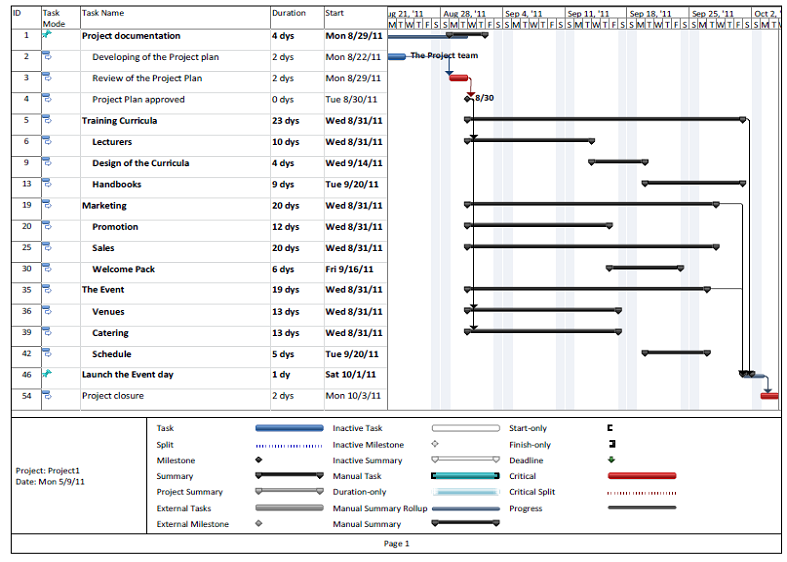
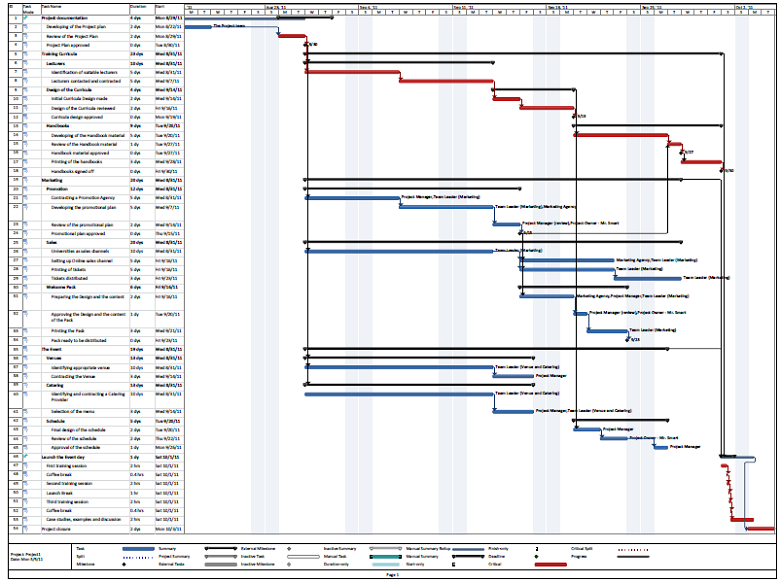
Project budget
The project schedule as presented in the preceding section serves for an estimation of the project cost in terms of expenses for each of the work packages – Table 2.
In the project management, the data on scheduling and budget come from the use of estimation techniques that are based on expert’s judgement. For example one of the techniques is when you write the minimum and the maximum and the most likely value and then calculate the actual expected cost, or the beta distribution from statistics. The cost does not follow the Project Life Cycle phases because the WBS is product based. It is a standard ‘best case approach’ for the event’s industry (Gardiner 2005). As a result the budget is made on the estimated cost for each of the WBS packages.
| Table 2. Project Budget | ||
| Project Management | £3,000 | |
| Lecturers | ||
| Academic lecturer (contract) | £2,000 | |
| Practitioners (Pro Bono) | £600 | |
| Promotional plan and Agency fee | £3,000 | |
| Promotional and Printed Material | £19,000 | |
| Sales fees | £400 | |
| Venue | £1,000 | |
| Catering | £1,000 | |
| Total | £30,000 | |
Project control and monitoring
Project control plans are an essential part of the project management documentation. These plans provide the control mechanisms of the project performance (PMI 2008, OGC 2005). According to PMI (2008) the PM control tools are divided in two sets of categories:
- Baseline vs. Actual activity and requirements, where the control and the monitoring is placed on the performance of the project participants and on the quality of the outputs. In the process monitoring the milestones is one of the most essential control mechanisms that are at disposal to the Project manager.
Apart from the baseline schedule and cost, another very important control tool in this category is the baseline quality plan. The plan sets the control of the project performance in terms of the required quality of the delivered outcomes, i.e. the results of the packages as identified with the Work Breakdown Structure. PM standard methodologies and practitioners recommend development of a quality approach, strategy and plans as part of project documentation. The development of the quality strategy is used to guide the future project activities in line with the identified quality requirements of the project, covering quality control and assurance (OCG2005, PMI 2008). Project management methodologies recommend a use of quality plans based on the product requirements from the WBS (PRINCE2, PMBOK) and the acceptance criteria developed in line with the customer requirements. As Turner (2009) and Gray and Larson (2010) argue, projects should have procedures, which clearly specify how projects are to be managed by qualified resources. Further, control procedures should not be bureaucratic, but sensible and flexible to meet customer requirements.
- The Baseline vs. Actual project cost – the control of the project cost is another essential project tool used to control the performance of projects according to initially allocated costs and resources.
The process of the project control is usually approached through the development of a Project responsibility matrix, which ensures that none of the project milestones and deliverables are developed, implemented or changed without a previous approval by all responsible participants. The project responsibility matrix is provided in Table 3.
| Table 3. Project Responsibility Matrix | ||||
| Project management | Training Curricula | Marketing | Event Day | |
| Project manager | A | I,R, S | I,R,S | I,A, R |
| Team Leader (Curricula) | I | A | I | I |
| Team Leader (Marketing) | I | I | A | I |
| Team Leader (Venue and catering) | I | I | I | A,I |
| Project owner | S,R | S,R | S,R | S,R |
| Marketing Agency | I | I | A,I | A,I |
| P Participant | A Accountable for the Task | R Review Required | I Input Required | S Sign-off Required |
Outline project risk register
According to standard PM methodologies it is very important to make an outline of the most important risks early in the process of project planning. The ‘risk identification and categorization is perceived as one of the most important elements of a successful project management’ (Turner 2009:210, PMI 2008). The risk categorisation is an actual grouping of the risks according to their impact on the project outcomes (schedule, cost and quality) or according to type of ownership over the risk (Turner 2009:213, PMI 2008). In the process, risks can be assessed as risks with high, moderate, or low impact on project objectives, or external – ones that are outside of the control of the company and internal – within the control of the company. Once the impact and the ownership of the risks are identified, risks are assessed and appropriate mitigation tactics developed. It is what the project management practitioners recognise as the risk management plan of the project (PMI 2008:230).
| Table 4. Risk identification | ||||||||
| No | Risk Category | Risk event | Impact (description) | Impact on project schedule | Impact on project cost | Likelihood | ||
| 1. | Lecturers | No adequate Lecturers are recruited on time; Lecturers cancel before the event; Lecturer gets sick or otherwise is prohibited to participate | The training cannot be realized at the scheduled day | High | High | 0.5 | ||
| 2. | Printer | An ambitious schedule for printing of the handbook. Financial problems. Printer lost key people and cannot deliver the handbook because of financial problems. | The handbook will not be ready for the training | Low | Medium | 0.5 | ||
| 3. | Venue | Electricity shortage; Equipment failure | The training cannot be realized at the scheduled day | High | High | 0.1 | ||
| 4. | Caterer | Financial problems; Delivery problems Quality and H&S problems | Launch and beverages will not be served at the event. | Low | low | 0.2 | ||
| 5. | Marketing Agency | Financial and or staff related Problems | The Promotional plan will not be ready on time. | Low | Medium | 0.1 | ||
The standard approach PMBOK (PMI 2008:303) recommends ‘two methods for reducing the risk exposure of projects: (1) avoidance, or elimination or substantial reduction of the risk and (2) transfer or deflection of the risk. The best approach is to avoid the risk when designing the project; however, this is sometimes impossible to do without jeopardising the project itself. In these cases the frequently used strategies for reducing the risk exposure of the project are changes in the project schedule, scope and even the objectives. The deflection or the transfer of the risk is associated with transferring the control over the risk to other project stakeholders – contractors or other parties (Turner 2009, PMI 2008). In the case of the Big Idea’s Project the recommended approach involves transferring the risk to contractors by designing and agreeing on specific contractual arrangements with financial penalties and incentives.
Recommendations
The recommendations for successful realisation of the project cover:
- Developing a detailed project documentation especially in the areas of the specification and the expected quality for the product deliverables;
- Developing detailed risk mitigation strategies especially for mitigating the inherent risks;
- Developing specific communication and reporting procedures which will ease the coordination of the activities and will favour fast reaction in risky situations;
- Hiring a team of two Academic lecturers, which will reduce the risk of Lecturer’s absence on the day of the project execution.
References and Bibliography
- Bowdin,G., et.al.,2006. Events Management. 2nd ed. Oxford: Butterworth-Heinemann.
- Chapman, C.B. et.al. (2003). Project risk management: processes, techniques, and insights. West Sussex:John Wiley and Sons.
- Gardiner, P. (2005). Project management: A strategic planning approach. Basingstoke, UK: Palgrave Macmillan.
- Gray, F. And Larson, W.E. (2010). Project Management 4ed. US: McGraw-Hill Higher Education.
- Field,M. and Keller L. (2007). Project Management. London:Thompson Learning.
- Houston, V. (2006). Chapter 9: Time Management in Practice. In , AMA Handbook of Project Management (pp. 81-88). American Management Association International.
- Kerzner, H.,2009. Project Management: A Systems Approach to Planning, Scheduling, and Controlling 10ed. Hoboken, NJ: John Wiley and Sons.
- Kloppenborg T, and Petrick J. (1999).Leadership in Project Life Cycle and Team Character Development. Project Management Journal .30(2), pp:8-20.
- Lewis, J. (2007). Chapter 5: Using the Work Breakdown Structure to Plan a Project. (pp. 56-68). In American Management Association International.
- Office of Government Commerce (2005). Managing Successful projects with PRINCE 2. TSO & Blackwell.
- Olsson N, Magnussen O., (2007). Flexibility at Different Stages in the Life Cycle of Projects: An Empirical Illustration of the “Freedom to Maneuver”. Project Management Journal . 38(4). pp:25-32.
- O’Toole, W. (2003). Using ‘project management’ in event management. Special Events, 22(13), 20
- Project Management Institute PMI. (2008). A guide to the Project management Body of Knowledge (PMBOK Guide) 4ed. Atlanta: PMI.
- Turner, J.R.(2009). The handbook of project-based management: leading strategic change in organizations 3rd. US:McGraw-Hill Professional.
- Project Learning Net (2011). Project mentor Learning Content. Available from: http://www.projectlearning.net/pdf/Project_Mentor_Learning_Content.pdf [Accessed 08.05.2011]
- Williams, T. (2003). Learning from Projects. The Journal of t